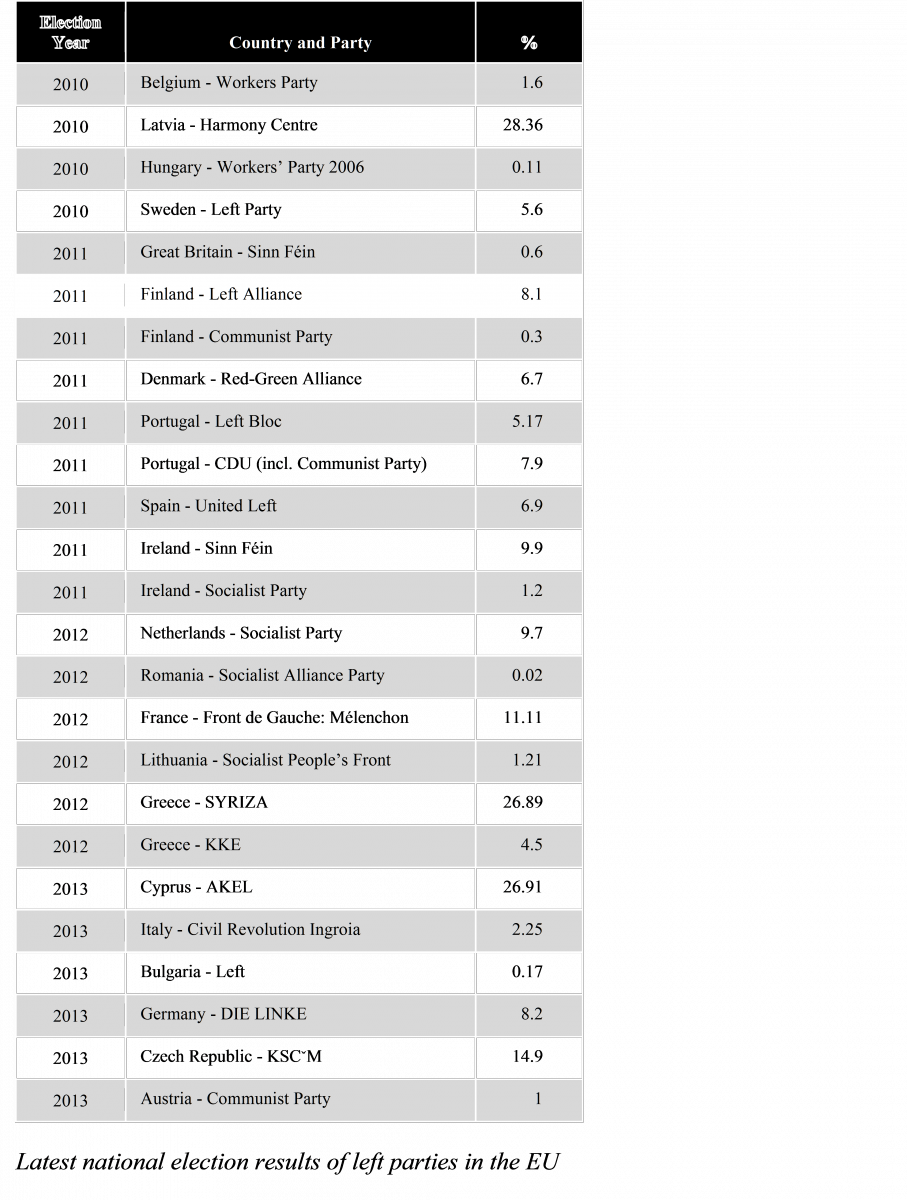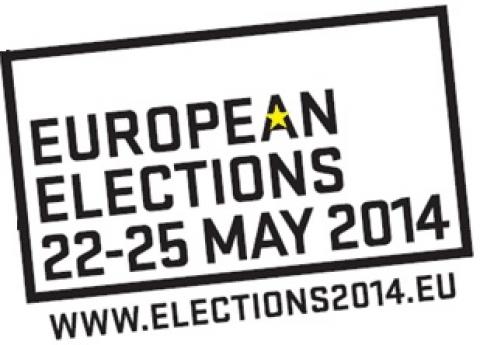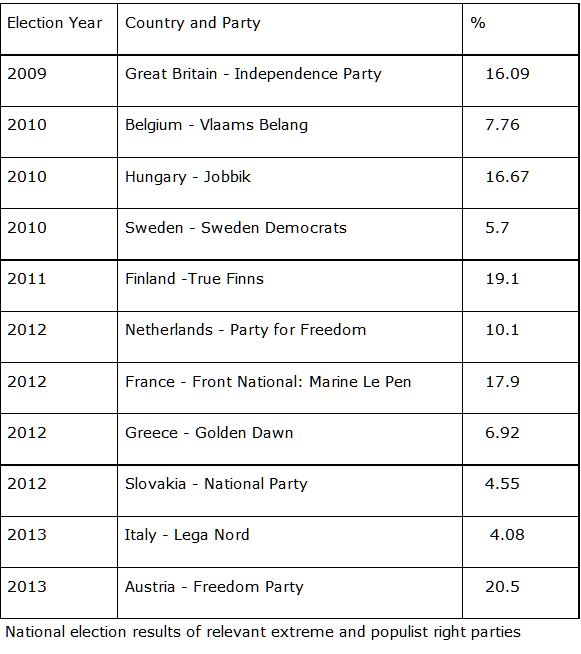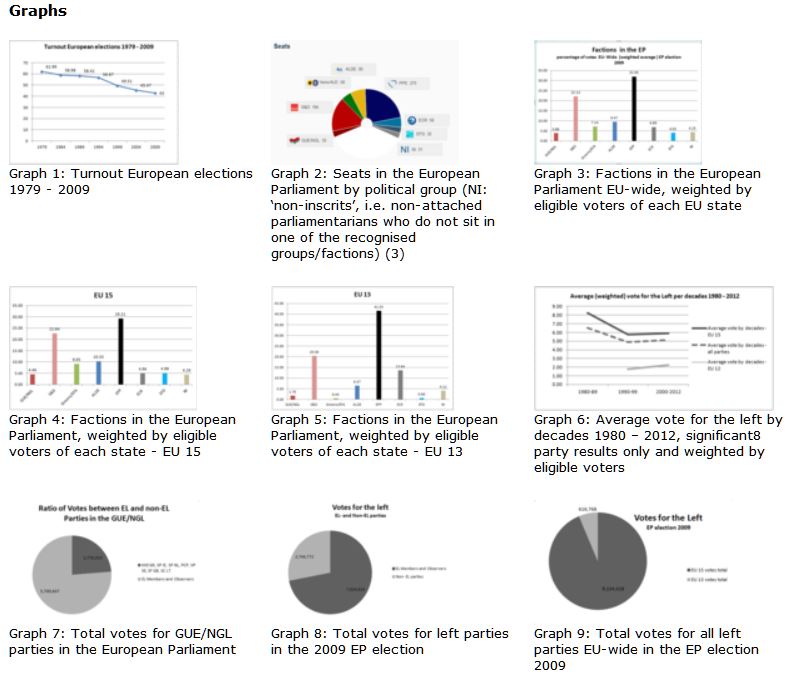At the beginning of November the European Parliament published an election forecast based on national election results and surveys, which took into account the quite different electoral systems in the 28 EU member states. These are the trends predicted:
- For the currently biggest faction, the Christian Democrats (The European People's Party - EPP), a drop from 275 to 226 seats is in the offing. A loss of votes is predicted in some of their strongholds such as France, Italy and Poland.
- According to the survey the centre parties will also be facing losses, the Liberals (from 85 down to 78) as well as the Greens (from 58 down to 40).
- A gain from 194 to 213 seats is predicted for the Social Democrats (Socialists & Democrats - S&D, that is, the Europe-wide party grouping social democratic parties). They could benefit from the British Labour Party's catching up again after its disastrous result in 2009.
- An increase of seats - from 35 to 59 - has also been forecast for the parties allied in the left parliamentary grouping GUE/NGL.
- The situation of both the extreme and populist right is unclear. Single parties of this spectrum can look forward to considerable gains. It is not yet clear whether the attempt of the six parties, which met in Vienna mid-November (FPÖ, Front National, Sweden Democrats, Lega Nord, Vlaams Belang and the Slovakian SNS) with the Dutch PVV, can successfully form a faction with the latter in the European Parliament. It is certain that whatever the outcome is it will be have important impact on the future of the two right-wing factions in the European Parliament.
The study quoted is highly interesting due to its complex and reliable methodology. However, we are sceptical of election forecasts as they may simply project the transient status quo of any given political point in time onto the future, when social and political circumstances may be very different. We think this is especially true of the current crisis-prone and unstable situation in Europe.
The European political landscape before the European elections
In what follows we will provide an overview of the basic features of the political landscape before the elections, with special reference to left parties. The trend in voter turnout is of fundamental significance for the political aspect of the crisis of European integration.
Irrespective of the turnout (see Graph 1 below), the elections to the European Parliament establish the political power ratio in the European Parliament.
The European People's Party (EPP) is currently the strongest faction (275 seats), followed by the Progressive Alliance of Socialists and Democrats (S&D - 194 seats), the Alliance of Liberals and Democrats for Europe (ALDE - 85 seats), The Greens - European Free Alliance (Verts/ALE - 58 seats), the faction of the European Conservatives and Reformists (ECR - 56 seats), led by the British and Czech conservatives, and the Europe of Freedom and Democracy (EFD - 32 seats), which mainly brings together nationalists and right-wing populists. 31 MEPs - among them 3 MEPs of the Hungarian neo-Nazi party Jobbik - are non-attached members (NI).
The European United Left/Nordic Green Left (GUE/NGL), which includes the MEPs of the Party of the European Left (EL), holds 35 seats.
For the seats in the European Parliament by political group see Graph 2 below
The conservative bloc torn on the question of integration
From 1999 to 2009, the EPP was in a European Parliament faction together with the European Democrats. One of the consequences of the financial and economic crisis reaching Europe in 2008 was the split of the conservative EU-sceptical parties from the European People's Party. They formed the ECR in 2009. Despite this attrition the EPP remained a broad and heterogeneous party with members ranging from Viktor Orbán's Fidesz (Hungary) to the French UMP, Berlusconi's Popolo della Libertà and Fredrik Rheinfeldt's Swedish Moderate Party.
There is still no pan-European general proportional suffrage. This affects the allocation of seats in the Parliament, which does not exactly reflect the distribution of votes actually cast for the various parties allied in factions. It is thus very instructive to look at the ratio of votes actually allocated to the factions. It shows that the votes given to parties (or factions respectively) have different weights. The four biggest factions in the EP (EPP, S&D, ALDE and Greens/EFA) won 70 % of the votes, but 80 % of the seats.
Factions in the European Parliament EU-wide, weighted by eligible voters of each EU state see Graph 3 below
The enlargements of the European Union (2004, 2007, 2013) did not merely increase the number of EU-inhabitants up to half a billion people but also changed its political landscape. Indeed European integration leads to a reciprocal political influence and an adjustment of political culture; however, the process is long and inconsistent. This can be deduced from the differing election results when comparing the states of the EU-15 and the EU-13 .
Factions in the European Parliament, weighted by eligible voters of each state - EU 15 see Graph 4 below
Factions in the European Parliament, weighted by eligible voters of each state - EU 13 (including Croatia) see Graph 5 below
A faction for the far right?
The plans to form a faction after the EP elections in 2014 have become more concrete. France's Front National and the Austrian Freedom Party (FPÖ) will probablygain votes and seats. Belgium's Vlaams Belang is represented by a non-attached MEP, the Sweden Democrats are likely to win seats in the European Parliament. All of them are members of the European party European Alliance for Freedom (EAF). Talks with Geert Wilders of the Dutch Party for Freedom (PVV - four non-attached MEPs) and the Lega Nord (six MEPs in the EFD faction) are under way.
As faction status requires a minimum of 25 MEPs from at least seven countries, the inclusion of the Slovak National Party (Slovenská Národná Strana - SNS) - which won 5.56 % and thus one seats in the last elections - is of strategic importance. The SNS won 4.55 % in the parliamentary elections of 2012 and is on the rise. Apparently, there will be no agreement with the British Independence Party (UKIP). A collaboration with the openly neo-Nazi parties (Jobbik, Golden Dawn, Germany's National Democratic Party, British National Party) has been rejected.
The following summary of relevant election results illustrates the prospects for the far and populist right:
The radical left parties
As the parties to the left of the social democrats and the Greens, despite all the transformations they have undergone, represent an historic continuity of emancipatory struggles and political organisation, their long-term perspective is important.
Average vote for the left by decades 1980 - 2012, significant8 party results only and weighted by eligible voters see Graph 6 below
We believe that the strength of these left parties is still primarily defined by their influence in their nation-states.


Parties grouped in the EP's GUE/NGL faction won 7,470,962 votes, of which 5,700,647 went to parties of the European Left (EL). Most - but not all - of the parties belonging to the GUE/NGL are members or observers of the EL.
Total votes for GUE/NGL parties in the European Parliament see Graph 7 below
Non-EL parties (comprising parties of different ideological profiles) in GUE/NGL are: Communist Party of Greece, Socialist Party Ireland, Socialist Party Netherlands, Portuguese Communist Party, Left Party Sweden, Sinn Féin Great Britain (Northern Ireland); Harmony Centre Latvia.
In total, 9,771,196 people in the EU voted for a left party. Member and observer parties of the EL (as well as alliances with the participation of EL parties) received 7,024,424 votes in the whole EU.
Total votes for left parties in the 2009 EP election see Graph 8 below
In addition to the non-EL parties in the GUE/NGL, the non-EL parties not represented in the European Parliament are: Left Ecology Freedom Italy; CP Luxembourg; Young Socialists Poland.
The EL parties in EU member states are: CP Austria, CP Belgium, Bulgarian Left, Communist Party of Bohemia and Moravia, Party of Democratic Socialism Czech Republic, AKEL Cyprus, Red Green Alliance Denmark, Estonian Left Party, Left Alliance Finland, CP Finland, French Communist Party, Party of the Left and Unitarian Left of Front de Gauche France, die LINKE Germany, German Communist Party, Syriza Greece, Renovative Communist and Ecological Left Greece, Workers' Party of Hungary 2006, Communist Refoundation Italy, Party of Communists Italy, The Left Luxembourg, Left Bloc Portugal, Communist Party of Slovakia, United Left Spain, Communist Party of Spain, United and Alternative Left Catalunya.
It is interesting that almost a fifth of the EL's 7,024,424 votes were cast for parties or alliances which did not win seats in the EP. Some 1,037,826 votes were cast for the electoral alliance Anticapitalist List of Italy's Rifondazione Comunista and the Party of Italian Communists. The electoral alliance Left Ecology Freedom (SEL) in Italy won 957,822 votes and likewise did not enter the EP.
Total votes for all left parties EU-wide in the EP election 2009 see Graph 9 below
There were at total of 9,771,196 votes Europe-wide for left parties. Of these the overwhelming majority, 9,154,428 came from the EU-15 countries. In the EU-13 countries 616,768 people voted for a left party. Among them are not only the parties in post-state-socialist countries but also Cyprus' AKEL with 106,922 votes.
The Communist Party of Bohemia and Moravia received 334,577 votes.
Also from this perspective, the expansion of the network and the influence of the EL in Central and Eastern Europe prove to be a key strategic issue. There is much to indicate that the upcoming elections for the European Parliament will be characterised by an increased polarisation. The chance exists that the left of the Left will be able to assert itself in these conflicts and thus increase its political weight. Yet, if and to which extent this chance can be realized will remain an open question until election day.
Translation: Tanja Mikolasch
Notes
- European Election 2014: simulation of composition of new Parliament - November 2013 update
- europarl.europa.eu http://www.europarl.europa.eu/aboutparliament/en/000cdcd9d4/Turnout-(1979-2009).html
- europarl.europa.eu http://www.europarl.europa.eu/meps/de/hemicycle.html
- Member parties of GUE/NGL (* EL party): AKEL - Progressive Party of Working People Cyprus*, Communist Party of Bohemia and Moravia*, Croatian Labourists - Labour Party, Red-Green Alliance Denmark*, French Communist Party*, Left Party France*, Communist Party of Réunion, LINKE Germany*, KKE - Communist Party of Greece, SYRIZA -Coalition of the Radical Left Greece*, Socialist Party Ireland, Socialist Party Latvia, Socialist Party Netherlands, Independent Party Netherlands, Left Bloc Portugal*, Portuguese Communist Party, Communist Party of Spain*, Left Party Sweden, Sinn Féin Northern Ireland.
- Austria, Belgium, Denmark, Finland, France, Germany, Greece, Ireland, Italy, Luxembourg, Netherlands, Portugal, Sweden, Spain and Great Britain.
- Bulgaria, Croatia, Cyprus, Czech Republic, Estonia, Hungary, Latvia, Lithuania, Malta, Poland, Romania, Slovenia and Slovakia.
- We adopt the term `radical left parties' here as is current use in political science, although it is not used by all the parties concerned.
- `Significant' here indicates the winning of the minimum number of deputies to national parliaments to achieve party presence at least once. Such parties are: EU 15: Denmark (EL), Finland (VAS), France (PCF), Germany (LINKE), Greece (KKE and Syn), Ireland (DL and SP), Italy (PRC/PdCI), Luxembourg (KPL and LÉNK), Netherlands (SP), Portugal (PCP and BE), Spain (PCE), Sweden (V) and UK (Scotland) (SSP and Respect); EU12: Cyprus (AKEL), Czech Republic (KSCM), Estonia (EÜVP), Latvia (LSP) and Slovakia (KSS).
- Luke March: Problems and perspectives of contemporary European radical left parties: Chasing a lost world or still a world to win? In: International Critical Thought, Volume 2, Issue 3, 2012
- Ibid.
[Barbara Steiner is a political scientist based in Vienna, a member of Transform.at and is working in the transform! europe coordination office.
Anna Striethorst is a PhD student in political sciences and a former associate researcher in the Brussels Office of the Rosa Luxemburg Foundation.
Walter Baier is an economist in Vienna and Coordinator of the network transform! europe.]




Spread the word